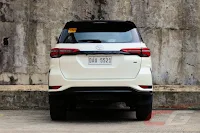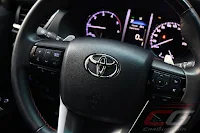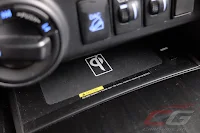By and large, Toyota got it right with the Fortuner. Just as 7-seater pickup-based SUVs were becoming a “thing” in 2005, the carmaker surprised everyone when they came out with one that was sleek. Since then, it’s managed to engrave itself into the hearts and minds of Filipinos as one of their most desired vehicles—one that transcends religion, political leanings, and socio-economic class. Whether you’re a DDS or Yellow (dilawan), boss or bodyguard, manager or rank-and-file employee, the Fortuner is something that everyone agreed on. And agreed on that it was good. Not perfect, mind you, but good.
As other carmakers entered the segment though, Toyota had to tweak their magic formula. In less than 20 years, the pickup-based SUV saw a big jump in both standard features and price. What started out as simple, honest-to-goodness, and dare I say it, agricultural vehicle soon turned into the new age luxury family car for many Filipinos. With feature sets matching, or even surpassing some premium brand equivalents, no one bats an eye now to see them priced above the P 2-million mark.
For example, this Fortuner, the 2021 2.8 LTD is P 2.414 million (the 2022 model with slightly more equipment goes up to P 2.440 million). This is, admittedly, not anymore within the financial reach of the typical Filipino family anymore (Toyota retained the G and V grades for them). Instead, this variant goes into uncharted waters—the often fussy, finicky, and often times snooty nouveau riche. So, is the Fortuner ready to climb up the social ladder or will its blue collared underpinnings show through its luxury trappings?
Things start out on a perfect note for the Fortuner 2.8 LTD. The raft of changes is concentrated on this variant, and it shows. Compared to lesser grades, this one feels the most complete. The unique grille, bumpers, and headlight treatment all look on point making it seem both sporty and elegant at the same time. It also has some de rigueur styling cues commonly associated with the word, “fancy” like the two-tone exterior paint and the sequential turn signal indicators. Some are berating Toyota for fitting in conservatively-sized 18-inch wheels compared to standard 20-inchers elsewhere, but personally, I’ll let that slide. What sticks out are the chrome door handles. Toyota managed to black out everything else, so why leave the door handles out? Weird.
With a high floor, getting inside the Fortuner requires a big climb. Thankfully, it’s got A-pillar grab bars to make the entire exercise a tad easier. First impressions are pretty good too. The construction can’t be faulted with every control including minor ones feeling mighty crisp and solid. The red accents dotting the seats, door trim, and center console as well as the LED ambient lighting manage to liven up the otherwise serious all-black color scheme as well. The front seats also get standard ventilated seats too.
Compared to the base G grade, the infotainment system is an inch bigger (8 inches all in all). It also comes standard with Apple CarPlay and Android Auto. Better still, it has a set of physical knobs and buttons too. The interface doesn’t look quite as high-tech as some of the others, but navigating through the menus is easy enough. This is great because some vehicle-related settings are found in there, with some, mostly related to Toyota Safety Sense, found in the instrument cluster. Unique to the LTD grade is a 9-speaker JBL system. It’s not as high on aural clarity as other branded speaker systems, but it does give some solid bass.
As a whole, Toyota’s managed to slowdown the effects of Father Time on the latest Fortuner, but if there’s one area where it’s rapidly falling behind, it’s through its interior comfort and flexibility. Mind you, interior space is solid, but good seat support is lacking across all three rows. The driver may enjoy a tilt/telescopic steering column and power adjustable seats, but the “best seating position” is actually a compromise. The arms are stretched out, and the knees tucked in. Knees also tend to scrape or hit the power windows switches too. It’s worst in the third row though where the amount of seat recline is limited. Plus, due to its side flip design, it’s hard to stow and eats into the cargo space.
The headline going into 2021 is its tweaked 2.8-liter engine. The 1GD-FTV now makes 204 horsepower and 500 Nm of torque—great numbers compared to before, and easily one of the best in its segment. The numbers just tell one part of the story though. What they don’t tell you is how polished it feels right now. Instead of relying on just displacement or boost, this engine uses both. As a result, it never runs out of breath. There’s power when you need it and when you want it. It’s also quieter and more refined. On more spirited drives, the 6-speed automatic is slow to shift, but during more sensible drives, it’s well-matched to the engine. Despite the added power, fuel economy remains the same—8.13 km/L at an average speed of 15 km/h.
When it comes to the infamous ride, it’s still pretty much what you’d expect. It’s firm and jiggly whenever it goes over small ruts and bumps. It’s particularly weak on undulating roads like those road corrugations on SLEX designed to slow you down at curves, or cracked concrete. It sends all sorts of shudders into the cabin almost unfiltered. As the tarmac smoothens, or weirdly enough, the potholes get larger, it smoothens out.
On the rare occasions when the Fortuner meets properly asphalted Manila roads, it’s actually an easy SUV to drive fast. Those accustomed to driving smaller, more agile vehicles will need just a few days to get acclimatized here. And even those who aren’t too confident at slotting it into tight spaces will be glad that Toyota’s now equipped it with corner sensors—two at the front and four back, and a Panoramic View Monitor or PVM too.
It’s worth saying though that PVM doesn’t work like your standard 360-degree camera. It doesn’t automatically engage when you hit Reverse, or when it detects objects through its sensors (it’s officially called Toyota Park Assist). The PVM system has to be turned on manually by pressing and holding the PVM button beside the Park Assist switch for three seconds (same steps to switch it off). It’s counterintuitive and makes you think Toyota meant it more as an off-road monitor rather than some kind of parking aid.
As for safety, the Fortuner LTD models come with Toyota Safety Sense or TSS. It bundles technology such as Pre-Collision Braking, Lane Departure Alert, and Adaptive Cruise Control into the mix (if you opt for the pricier 2022 model, it adds blind spot indicators with rear cross-traffic alert too). The system’s pretty solid and ingenious. Compared to other systems which only warns the driver of a lane departure, the Fortuner actively provides assistance—and this is despite sticking to a hydraulic power steering setup. Toyota has done it by using the brakes. By applying a small amount of braking force (Yaw Assist), it helps keep itself in the lane. It’s not the most elegant or intuitive solution, but it’s a solution nonetheless. Besides, these functions can be turned off easily using shortcut buttons on the steering wheel.
Now, going back to our question, does the Fortuner, especially in 2.8 LTD trim manage to pass itself as a status symbol, or does its humble origins make it a faux pas? The answer to that question largely depends on who’s buying. If he’s used to something simpler, or wants a bit of luxury while still keeping up a humble image persona, this top-of-the-line Fortuner does that. It manages to make itself look and feel more upscale, and would fit in in just about every Filipino driveway. On the other hand, if the buyer’s already used to a bit of luxury, say he’s switching over from an older Land Cruiser Prado, the Fortuner’s less than premium interior packaging and ride sticks out as definite weak points. Ultimately though, Toyota has provided the power of choice, and the Fortuner is about being a safe choice. Again, it’s not perfect, but it’s an agreeable one.
|
2021 Toyota Fortuner 2.8 LTD 4x4 |
|
| Ownership | 2021 Toyota Fortuner 2.8 LTD 4x4 |
| Year Introduced | 2016 (Refreshed: 2020) |
| Vehicle Classification | Mid-sized SUV |
| Warranty | 3 years / 100,000 kilometers |
| The Basics | |
| Body Type | 5-door SUV |
| Seating | 7 |
| Engine / Drive | F/4WD, Part-Time, Low, Locking |
| Under the Hood | |
| Displacement (liters) | 2.8 |
| Aspiration | Turbocharged |
| Fuel Delivery | Common Rail |
| Layout / # of Cylinders | I4 |
| BHP @ rpm | 204 @ 3,400 |
| Nm @ rpm | 500 @ 1,600-2,800 |
| Fuel / Min. Octane | Diesel |
| Transmission | 6 AT |
| Cruise Control | Yes, Adaptive |
| Fuel Economy @ Ave. Speed | 8.13 km/L @ 15 km/h |
| Dimensions and Weights | |
| Length (mm) | 4,795 |
| Width (mm) | 1,855 |
| Height (mm) | 1,835 |
| Wheelbase (mm) | 2,745 |
| Curb Weight (kg) | 2,180 |
| Suspension and Tires | |
| Front Suspension | Independent, Double Wishbone |
| Rear Suspension | 5-Link, Coil Spring |
| Front Brakes | Vented Disc |
| Rear Brakes | Vented Disc |
| Parking Brake | Manual |
| Tires | Bridgestone Dueler H/T 284 II 265/60 R 18 H (f & r) |
| Wheels | Alloy |
| Safety Features | |
| Airbags | 7 |
| Anti-Lock Brakes (ABS) | Yes, with EBD |
| Traction / Stability Control | Yes |
| Parking Sensors | Yes, Front & Rear |
| Parking Camera | Yes, 360-degree |
| Front Seatbelts | 3-pt ELR with pre-tensioner x 2 |
| Rear Seatbelts |
3-pt ELR x 3 (2nd row), 3-pt ELR x 2 (3rd row) |
| ISOFIX Child Seat Anchor | Yes |
| Other Safety Features |
Hill Start Assist Hill Descent Control Pre-Collision System Lane Departure Alert w/ Yaw Assist |
| Exterior Features | |
| Headlights | LED |
| Fog Lamps | Yes, Front (LED) |
| Auto Lights | Yes |
| Rain-sensing Wipers | No |
| Tailgate | Power |
| Interior Features | |
| Steering Wheel Adjust | Tilt/Telescopic |
| Steering Wheel Material | Leather/Galaxy Black |
| Seating Adjustment (driver) | Electric, 8-way, Ventilated |
| Seating Adjustment (front passenger) | Manual, 6-way, Ventilated |
| Seating Surface | Leather |
| Folding Rear Seat |
Yes, 60/40 (2nd row), 50/50 (3rd row) |
| Sunroof | No |
| Trip Computer | Yes |
| Convenience Features | |
| Power Steering | Yes |
| Power Door Locks | Yes |
| Power Windows | Yes |
| Power Mirrors | Yes, w/ Fold |
| Rear View Mirror | Auto-dimming |
| Proximity Key | Yes |
| Climate Control | Auto (Front), Manual (Rear), w/ Rear Vents |
| Audio System |
Stereo USB Bluetooth |
| Smartphone Connectivity |
Apple CarPlay Android Auto |
| # of Speakers | 9, JBL |
| Steering Controls | Yes |


























Hari ng tagtag
ReplyDeleteThe button placements are ridiculous, it's all over the place and all different sizes. There are 4 available blank buttons behind the eco/sport/normal modes, yet the traction control and diff lock use half sized buttons to fit in one button. The 360 camera and power tailgate is also such an afterthought. Add the low quality and outdated interior,and you got ab unrefined day-to-day experience. Unacceptable for anything above 2m pesos. Okay on a commercial vehicle like the Hilux, but definitely not on a private day-to-day commuter.
ReplyDeleteWow TMP! Talk about packaging!...I mean short-changing haha..
ReplyDelete